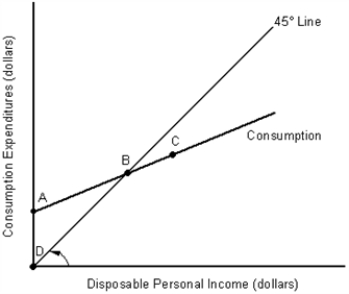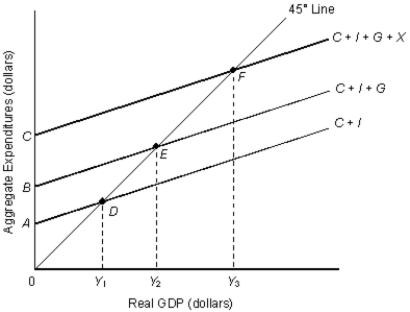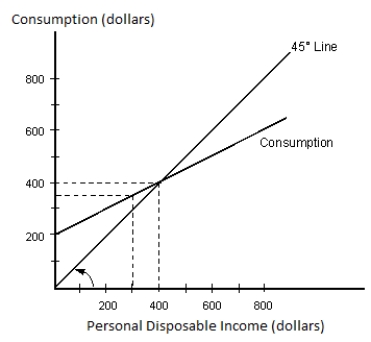Correct Answer

verified
Correct Answer
verified
Multiple Choice
Which of the following is a stock variable?
A) Government spending
B) Investment
C) Daily household consumption
D) Saving
E) Wealth
Correct Answer

verified
Correct Answer
verified
Multiple Choice
When capacity utilization rate is high:
A) the price level is likely to go up.
B) consumption is likely to go down.
C) investment is likely to increase.
D) the rate of interest is likely to decrease.
E) aggregate supply of goods is likely to remain constant.
Correct Answer

verified
Correct Answer
verified
Multiple Choice
Keynesian economics developed in response to:
A) the Great Depression of the 1930s.
B) the inflation following World War II.
C) economic growth during the 1950s.
D) the Vietnam War.
E) the oil embargo in the 1970s.
Correct Answer

verified
Correct Answer
verified
Multiple Choice
Identify the correct statement with respect to consumption and saving function.
A) Both the consumption function and the saving function have negative slopes.
B) As disposable income declines, consumption and saving increase.
C) The consumption function has a negative slope while the saving function has a positive slope.
D) As disposable income rises, consumption and saving increases.
E) The consumption function has a positive slope while the saving function has a negative slope.
Correct Answer

verified
Correct Answer
verified
Multiple Choice
As disposable income rises:
A) consumption falls, but not by as much as the disposable income rises.
B) the average propensity to consume increases.
C) saving falls as a percentage of disposable income.
D) the average propensity to consume remains unchanged.
E) saving rises as a percentage of disposable income.
Correct Answer

verified
Correct Answer
verified
True/False
If disposable income rises from $15,000 to $20,000 and the marginal propensity to consume equals 0.9, then saving must increase by $500.
Correct Answer

verified
Correct Answer
verified
Multiple Choice
Which of the following is true of long-run consumption functions?
A) Autonomous consumption is equal to zero in the long-run.
B) The long run consumption functions are steeper than short run consumption functions.
C) The marginal propensity to consume for the long run consumption function is almost equal to zero.
D) The autonomous consumption is negative in long run consumption functions.
E) The long run consumption function is represented by a straight line parallel to the horizontal axis.
Correct Answer

verified
Correct Answer
verified
True/False
When government spending is added to consumption and planned investment, the slope of the aggregate expenditure function increases.
Correct Answer

verified
Correct Answer
verified
Multiple Choice
In the table given below Y represents the aggregate expenditure of the economy on C = consumption, I = investment, G = government projects, and X = net exports.?
 -Refer to Table 9.3. Compute the marginal propensity to save in the economy.
-Refer to Table 9.3. Compute the marginal propensity to save in the economy.
A) 0.10
B) 0.20
C) 0.25
D) 0.50
E) 0.75
Correct Answer

verified
Correct Answer
verified
Multiple Choice
The figure given below shows the consumption function of a household.?Figure 9.2
 -In Figure 9.2, the line segment AD represents:
-In Figure 9.2, the line segment AD represents:
A) autonomous consumption.
B) the maximum amount of saving.
C) negative consumption.
D) zero consumption.
E) autonomous expenditure.
Correct Answer

verified
Correct Answer
verified
Multiple Choice
The figure given below shows the aggregate expenditures function of an economy.?Figure 9.5
 -Refer to Figure 9.5. Which of the following statements is true?
-Refer to Figure 9.5. Which of the following statements is true?
A) Autonomous net exports equal the distance between A and C.
B) Autonomous consumption is equal to the distance between A and C.
C) There is a deficit in the merchandise and services account.
D) Exports exceed imports for the country in question.
E) Autonomous consumption is equal to the distance between 0 and C.
Correct Answer

verified
Correct Answer
verified
True/False
If capacity utilization by businesses remains constant, investment spending is likely to be the most volatile component of aggregate expenditures in the United States.
Correct Answer

verified
Correct Answer
verified
Multiple Choice
The figure given below represents the consumption function of a country.?Figure 9.3
 -Refer to Figure 9.3. We can infer that the marginal propensity to save would be _____.
-Refer to Figure 9.3. We can infer that the marginal propensity to save would be _____.
A) 0.7
B) 0.1
C) 0.4
D) 0.25
E) 0.5
Correct Answer

verified
Correct Answer
verified
True/False
As disposable income increases, consumption spending will rise, but it will rise by less than disposable income if the MPS is positive.
Correct Answer

verified
Correct Answer
verified
Multiple Choice
 -Refer to Table 9.2. If a firm purchases the machine by taking out a one-year loan, what happens to the firm's rate of return on the investment if the interest rate increases to 10 percent?
-Refer to Table 9.2. If a firm purchases the machine by taking out a one-year loan, what happens to the firm's rate of return on the investment if the interest rate increases to 10 percent?
A) It increases to 1.5 percent
B) It increases to 0.15 percent
C) It decreases to 1.5 percent
D) It decreases to 1.7 percent
E) It decreases to 0.17 percent
Correct Answer

verified
Correct Answer
verified
Multiple Choice
The figure given below represents the consumption function of a country.?Figure 9.3
 -Refer to Figure 9.3. When disposable income is $800, consumption spending must equal:
-Refer to Figure 9.3. When disposable income is $800, consumption spending must equal:
A) $200.
B) $700.
C) $600.
D) $800.
E) $400.
Correct Answer

verified
Correct Answer
verified
Multiple Choice
The aggregate expenditures function:
A) has the same slope as the aggregate demand curve.
B) is the key determinant of equilibrium real GDP in a fixed-price model.
C) is negatively related to household consumption.
D) is negatively related to net exports.
E) is equal to C+I+G-X.
Correct Answer

verified
Correct Answer
verified
Multiple Choice
If a household's disposable income increases from $50,000 to $100,000 and its consumption increases from $40,000 to $80,000, the MPS must be _____.
A) 0.4
B) 0.8
C) 0.7
D) 0.2
E) 0.5
Correct Answer

verified
Correct Answer
verified
True/False
Other things equal, an increase in the consumer confidence index tends to raise the average propensity to consume.
Correct Answer

verified
Correct Answer
verified
Showing 21 - 40 of 120
Related Exams